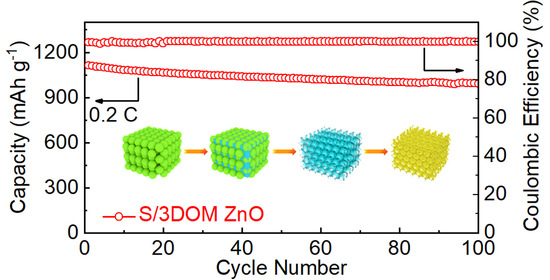Three-Dimensionally Ordered Macroporous ZnO Framework as Dual-Functional Sulfur Host for High-Efficiency Lithium–Sulfur Batteries
Abstract
1. Introduction
2. Materials and Methods
2.1. Preparation of PMMA@Precursor
2.2. Preparation of 3DOM ZnO and 3D ZnO
2.3. Preparation of S/3DOM ZnO
2.4. Material Characterizations
2.5. Electrochemical Characterizations
2.6. Symmetric Cell Test
2.7. Linear Sweep Voltammetry Measurement
2.8. Li2S Nucleation and Precipitation Test
2.9. Absorption Experiment
3. Results and Discussion
4. Conclusions
Supplementary Materials
Author Contributions
Funding
Conflicts of Interest
References
- Tian, Y.; Li, G.; Zhang, Y.; Luo, D.; Wang, X.; Zhao, Y.; Liu, H.; Ji, P.; Du, X.; Li, J.; et al. Low-Bandgap Se-Deficient Antimony Selenide as a Multifunctional Polysulfide Barrier toward High-Performance Lithium-Sulfur Batteries. Adv. Mater. 2020, 32, 1904876. [Google Scholar] [CrossRef] [PubMed]
- Zhang, Y.; Li, G.; Wang, J.; Cui, G.; Wei, X.; Shui, L.; Kempa, K.; Zhou, G.; Wang, X.; Chen, Z. Hierarchical Defective Fe3−xC@C Hollow Microsphere Enables Fast and Long-Lasting Lithium-Sulfur Batteries. Adv. Funct. Mater. 2020, 30, 2001165. [Google Scholar] [CrossRef]
- Wang, Y.; Zhang, R.; Chen, J.; Wu, H.; Lu, S.; Wang, K.; Li, H.; Harris, C.; Xi, K.; Kumar, R.; et al. Enhancing Catalytic Activity of Titanium Oxide in Lithium-Sulfur Batteries by Band Engineering. Adv. Energy Mater. 2019, 9, 1900953. [Google Scholar] [CrossRef]
- Zhang, J.; Li, G.; Zhang, Y.; Zhang, W.; Wang, X.; Zhao, Y.; Li, J.; Chen, Z. Vertically rooting multifunctional tentacles on carbon scaffold as efficient polysulfide barrier toward superior lithium-sulfur batteries. Nano Energy 2019, 64, 103905. [Google Scholar] [CrossRef]
- Gueon, D.; Hwang, J.; Yang, S.; Cho, E.; Sohn, K.; Yang, D.; Moon, J. Spherical Macroporous Carbon Nanotube Particles with Ultrahigh Sulfur Loading for Lithium-Sulfur Battery Cathodes. ACS Nano 2018, 12, 226–233. [Google Scholar] [CrossRef] [PubMed]
- Xu, J.; Zhang, W.; Fan, H.; Cheng, F.; Su, D.; Wang, G. Promoting lithium polysulfide/sulfide redox kinetics by the catalyzing of zinc sulfide for high performance lithium-sulfur battery. Nano Energy 2018, 51, 73–82. [Google Scholar] [CrossRef]
- Paolella, A.; Zhu, W.; Marceau, H.; Kim, C.S.; Feng, Z.; Liu, D.; Gagnon, C.; Trottier, J.; Abdelbast, G.; Hovington, P.; et al. Transient existence of crystalline lithium disulfide Li2S2 in a lithium-sulfur battery. J. Power Sources 2016, 325, 641–645. [Google Scholar] [CrossRef]
- Zhu, W.; Paolella, A.; Kim, C.S.; Liu, D.; Feng, Z.; Gagnon, C.; Trottier, J.; Vijh, A.; Guerfi, A.; Mauger, A.; et al. Investigation of the reaction mechanism of lithium sulfur batteries in different electrolyte systems by in situ raman spectroscopy and in situ X-ray diffraction. Sustain. Energy Fuels 2017, 1, 737–747. [Google Scholar] [CrossRef]
- Carbone, L.; Coneglian, T.; Gobet, M.; Munoz, S.; Devany, M.; Greenbaum, S.; Hassoun, J. A simple approach for making a viable, safe, and high-performances lithium-sulfur battery. J. Power Sources 2018, 377, 26–35. [Google Scholar] [CrossRef]
- Liu, J.; Yuan, L.; Yuan, K.; Li, Z.; Hao, Z.; Xiang, J.; Huang, Y. SnO2 as a high-efficiency polysulfide trap in lithium-sulfur batteries. Nanoscale 2016, 8, 13638–13645. [Google Scholar] [CrossRef]
- Marceau, H.; Kim, C.S.; Paolella, A.; Ladouceur, S.; Lagacé, M.; Chaker, M.; Vijh, A.; Guerfi, A.; Julien, C.M.; Mauger, A.; et al. In operando scanning electron microscopy and ultraviolet-visible spectroscopy studies of lithium/sulfur cells using all solid-state polymer electrolyte. J. Power Sources 2016, 319, 247–254. [Google Scholar] [CrossRef]
- Hu, Y.; Chen, W.; Lei, T.; Jiao, Y.; Huang, J.; Hu, A.; Gong, C.; Yan, C.; Wang, X.; Xiong, J. Strategies toward High-Loading Lithium-Sulfur Battery. Adv. Energy Mater. 2020, 10, 2000082. [Google Scholar] [CrossRef]
- Maugera, A.; Juliena, C.M.; Paolella, A.; Armand, M.; Zaghib, K. A comprehensive review of lithium salts and beyond for rechargeable batteries: Progress and perspectives. Mater. Sci. Eng. R Rep. 2018, 134, 1–21. [Google Scholar] [CrossRef]
- Mauger, A.; Julien, C.M.; Paolella, A.; Armand, M.; Zaghib, K. Building Better Batteries in the Solid State: A Review. Materials 2019, 12, 3892. [Google Scholar] [CrossRef]
- Zhu, W.; Liu, D.; Paolella, A.; Gagnon, C.; Gariepy, V.; Vijh, A.; Zaghib, K. Application of Operando X-ray Diffraction and Raman Spectroscopies in Elucidating the Behavior of Cathode in Lithium-Ion Batteries. Front. Energy Res. 2018, 6, 66. [Google Scholar] [CrossRef]
- Kim, J.; Kang, Y.; Song, S.; Suk, J. Freestanding sulfur-graphene oxide/carbon composite paper as a stable cathode for high performance lithium-sulfur batteries. Electrochim. Acta 2019, 299, 27–33. [Google Scholar] [CrossRef]
- He, J.; Luo, L.; Chen, Y.; Manthiram, A. Yolk-Shelled C@Fe3O4 Nanoboxes as Efficient Sulfur Hosts for High-Performance Lithium-Sulfur Batteries. Adv. Mater. 2017, 29, 1702707. [Google Scholar] [CrossRef]
- Chen, K.; Sun, Z.; Fang, R.; Shi, Y.; Cheng, H.; Li, F. Metal-Organic Frameworks (MOFs)-Derived Nitrogen-Doped Porous Carbon Anchored on Graphene with Multifunctional Effects for Lithium-Sulfur Batteries. Adv. Funct. Mater. 2018, 28, 1707592. [Google Scholar] [CrossRef]
- Zhang, T.; Wang, H.; Zhao, J. Heterostructures of doped graphene and MoX2 (X = S and Se) as promising anchoring materials for lithium-sulfur batteries: A first-principles study. N. J. Chem. 2019, 43, 9396–9402. [Google Scholar] [CrossRef]
- Zhang, H.; Zhao, W.; Zou, M.; Wang, Y.; Chen, Y.; Xu, L.; Wu, H.; Cao, A. 3D, Mutually Embedded MOF@Carbon Nanotube Hybrid Networks for High-Performance Lithium-Sulfur Batteries. Adv. Energy Mater. 2018, 8, 1800013. [Google Scholar] [CrossRef]
- Zheng, J.; Tian, J.; Wu, D.; Gu, M.; Xu, W.; Wang, C.; Gao, F.; Engelhard, M.; Zhang, J.; Liu, J.; et al. Lewis acid-base interactions between polysulfides and metal organic framework in lithium sulfur batteries. Nano Lett. 2014, 14, 2345–2352. [Google Scholar] [CrossRef] [PubMed]
- Hong, X.; Tan, T.; Guo, Y.; Tang, X.; Wang, J.; Qin, W.; Cai, Y. Confinement of polysulfides within bi-functional metal-organic frameworks for high performance lithium-sulfur batteries. Nanoscale 2018, 10, 2774–2780. [Google Scholar] [CrossRef]
- Sun, Y.; Zhao, Y.; Cui, Y.; Zhang, J.; Zhang, G.; Luo, W.; Zheng, W. A Facile Synthesis of Mesoporous TiO2 Sub-Microsphere Host for Long Life Lithium-Sulfur Battery Cathodes. Electrochim. Acta 2017, 239, 56–64. [Google Scholar] [CrossRef]
- Hu, L.; Dai, C.; Liu, H.; Li, Y.; Shen, B.; Chen, Y.; Bao, S.; Xu, M. Double-Shelled NiO-NiCo2O4 Heterostructure@Carbon Hollow Nanocages as an Efficient Sulfur Host for Advanced Lithium-Sulfur Batteries. Adv. Energy Mater. 2018, 8, 1800709. [Google Scholar] [CrossRef]
- Chen, G.; Zhong, W.; Li, Y.; Deng, Q.; Ou, X.; Pan, Q.; Wang, X.; Xiong, X.; Yang, C.; Liu, M. Rational Design of TiO-TiO2 Heterostructure/Polypyrrole as a Multifunctional Sulfur Host for Advanced Lithium-Sulfur Batteries. ACS Appl. Mater. Interfaces 2019, 11, 5055–5063. [Google Scholar] [CrossRef] [PubMed]
- He, J.; Hartmann, G.; Lee, M.; Hwang, G.; Chen, Y.; Manthiram, A. Freestanding 1T MoS2/graphene heterostructures as a highly efficient electrocatalyst for lithium polysulfides in Li-S batteries. Energy Environ. Sci. 2019, 12, 344–350. [Google Scholar] [CrossRef]
- Zhou, T.; Lv, W.; Li, J.; Zhou, G.; Zhao, Y.; Fan, S.; Liu, B.; Li, B.; Kang, F.; Yang, Q. Twinborn TiO2-TiN heterostructures enabling smooth trapping-diffusion-conversion of polysulfides towards ultralong life lithium-sulfur batteries. Energy Environ. Sci. 2017, 10, 1694–1703. [Google Scholar] [CrossRef]
- Song, Y.; Wang, H.; Yu, W.; Wang, J.; Liu, G.; Li, D.; Wang, T.; Yang, Y.; Dong, X.; Ma, Q. Synergistic stabilizing lithium sulfur battery via nanocoating polypyrrole on cobalt sulfide nanobox. J. Power Sources 2018, 405, 50–51. [Google Scholar] [CrossRef]
- Li, H.; Wang, J.; Zhao, Y.; Yang, S.; Tian, Y.; Wang, Y. S-ZnO/CNTs Microspheres Prepared by Spray Drying for Improved Cathodes in Lithium-Sulfur Batteries. ChemElectroChem 2019, 6, 3454–3459. [Google Scholar] [CrossRef]
- Zeng, P.; Yu, H.; Chen, M.; Xiao, M.; Li, Y.; Liu, H.; Luo, J.; Peng, J.; Shao, D.; Zhou, Z.; et al. Flower-like ZnO modified with BiOI nanoparticles as adsorption/catalytic bifunctional hosts for lithium-sulfur batteries. J. Energy Chem. 2020, 51, 21–29. [Google Scholar] [CrossRef]
- Liang, C.; Zhang, X.; Zhao, Y.; Tan, T.; Zhang, Y.; Bakenov, Z. Three-dimensionally ordered macro/mesoporous TiO2 matrix to immobilize sulfur for high performance lithium/sulfur batteries. Nanotechnology 2018, 29, 415401. [Google Scholar] [CrossRef] [PubMed]
- Zhang, Y.; Qiu, W.; Zhao, Y.; Wang, Y.; Bakenov, Z.; Wang, X. Ultra-fine zinc oxide nanocrystals decorated three-dimensional macroporous polypyrrole inverse opal as efficient sulfur hosts for lithium/sulfur batteries. Chem. Eng. J. 2019, 375, 122055. [Google Scholar] [CrossRef]
- Hou, J.; Tu, X.; Wu, X.; Shen, M.; Wang, X.; Wang, C.; Cao, C.; Pang, H.; Wang, G. Remarkable cycling durability of lithium-sulfur batteries with interconnected mesoporous hollow carbon nanospheres as high sulfur content host. Chem. Eng. J. 2020, 401, 126141. [Google Scholar] [CrossRef]
- Cui, G.; Li, G.; Luo, D.; Zhang, Y.; Zhao, Y.; Wang, D.; Wang, J.; Zhang, Z.; Wang, X.; Chen, Z. Three-dimensionally ordered macro-microporous metal organic frameworks with strong sulfur immobilization and catalyzation for high-performance lithium-sulfur batteries. Nano Energy 2020, 72, 104685. [Google Scholar] [CrossRef]
- Huang, J.; Cao, B.; Zhao, F.; Zhang, L.; Qu, Y.; Chen, Y. A mulberry-like hollow carbon cluster decorated by Al-doped ZnO particles for advanced lithium-sulfur cathode. Electrochim. Acta 2019, 304, 62–69. [Google Scholar] [CrossRef]
- Chen, G.; Li, Y.; Zhong, W.; Zheng, F.; Hu, J.; Ji, X.; Liu, W.; Yang, C.; Lin, Z.; Liu, M. MOFs-derived porous Mo2C-C nano-octahedrons enable high-performance lithium-sulfur batteries. Energy Storage Mater. 2020, 25, 547–554. [Google Scholar] [CrossRef]
- Qi, W.; Jiang, W.; Xu, F.; Jia, J.; Yang, C.; Cao, B. Improving confinement and redox kinetics of polysufides through hollow NC@CeO2 nanospheres for high-performance lithium-sulfur batteries. Chem. Eng. J. 2020, 382, 122852. [Google Scholar] [CrossRef]
- Wang, Y.; Luo, R.; Zhang, Y.; Guo, Y.; Lu, Y.; Liu, X.; Kim, J.; Luo, Y. Tungsten Nitride/Carbon Cloth as Bifunctional Electrode for Effective Polysulfide Recycling. ACS Appl. Energy Mater. 2019, 2, 3314–3322. [Google Scholar] [CrossRef]
- Li, N.; Xu, Z.; Wang, P.; Zhang, Z.; Hong, B.; Li, J.; Lai, Y. High-rate lithium-sulfur batteries enabled via vanadium nitride nanoparticle/3D porous graphene through regulating the polysulfides transformation. Chem. Eng. J. 2020, 398, 125432. [Google Scholar] [CrossRef]
- Zheng, B.; Yu, L.; Li, N.; Xi, J. Efficiently immobilizing and converting polysulfide by a phosphorus doped carbon microtube textile interlayer for high-performance lithium-sulfur batteries. Electrochim. Acta 2020, 345, 136186. [Google Scholar] [CrossRef]
- Jiao, L.; Zhang, C.; Geng, C.; Wu, S.; Li, H.; Lv, W.; Tao, Y.; Chen, Z.; Zhou, G.; Li, J.; et al. Capture and Catalytic Conversion of Polysulfides by In Situ Built TiO2-MXene Heterostructures for Lithium-Sulfur Batteries. Adv. Energy Mater. 2019, 9, 1900219. [Google Scholar] [CrossRef]
- Barghamadi, M.; Best, A.S.; Bhatt, A.I.; Hollenkamp, A.F.; Mahon, P.J.; Musameh, M.; Rüther, T. Effect of LiNO3 additive and pyrrolidinium ionic liquid on the solid electrolyte interphase in the lithium-sulfur battery. J. Power Sources 2015, 295, 212–220. [Google Scholar] [CrossRef]
- Li, H.; Sun, L.; Zhao, Y.; Tan, T.; Zhang, Y. Blackberry-like hollow graphene spheres synthesized by spray drying for high-performance lithium-sulfur batteries. Electrochim. Acta 2019, 295, 822–828. [Google Scholar] [CrossRef]
- Hao, Q.; Cui, G.; Zhang, Y.; Li, J.; Zhang, Z. Novel MoSe2/MoO2 heterostructure as an effective sulfur host for high-performance lithium/sulfur batteries. Chem. Eng. J. 2020, 381, 122672. [Google Scholar] [CrossRef]


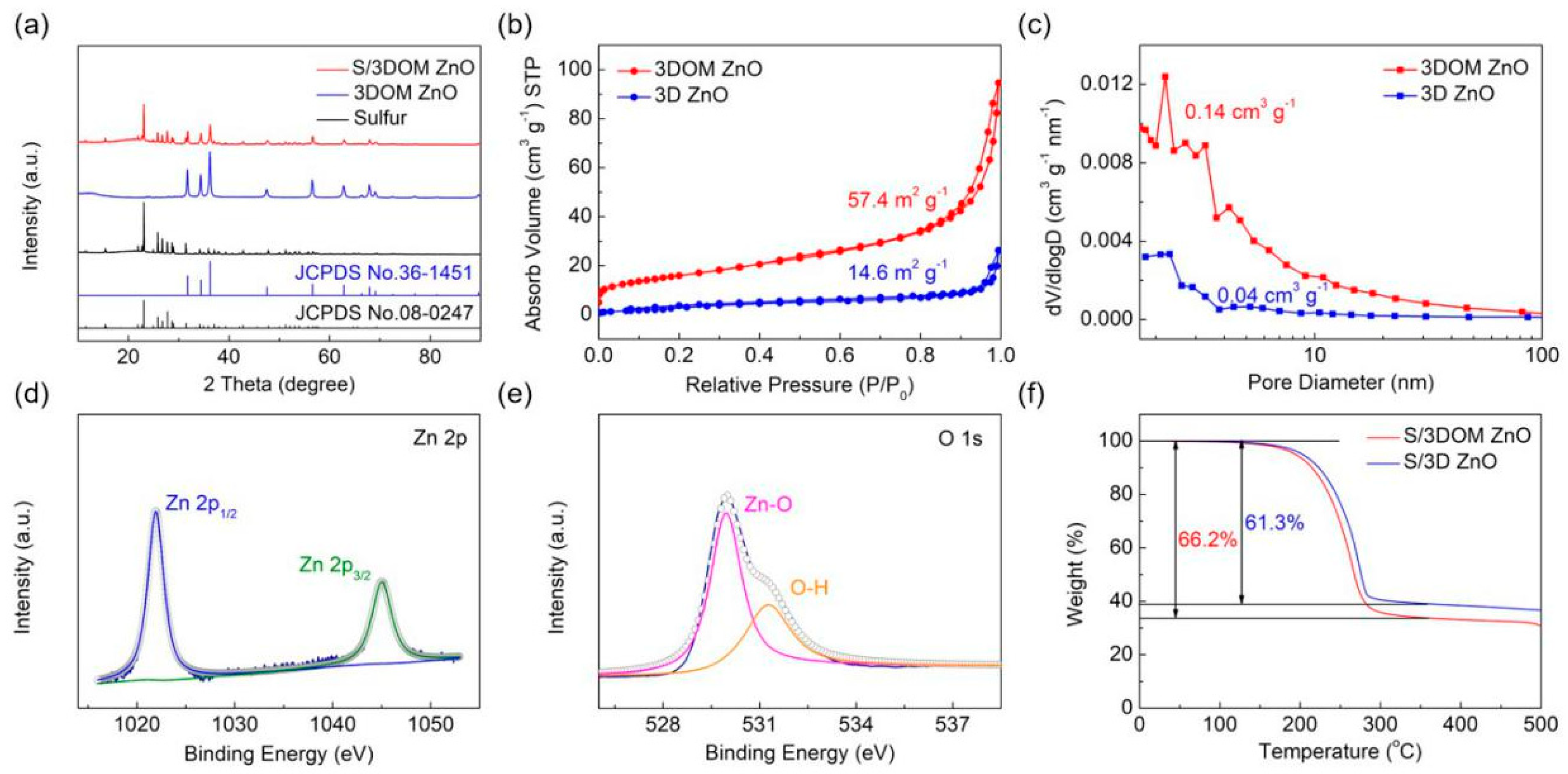
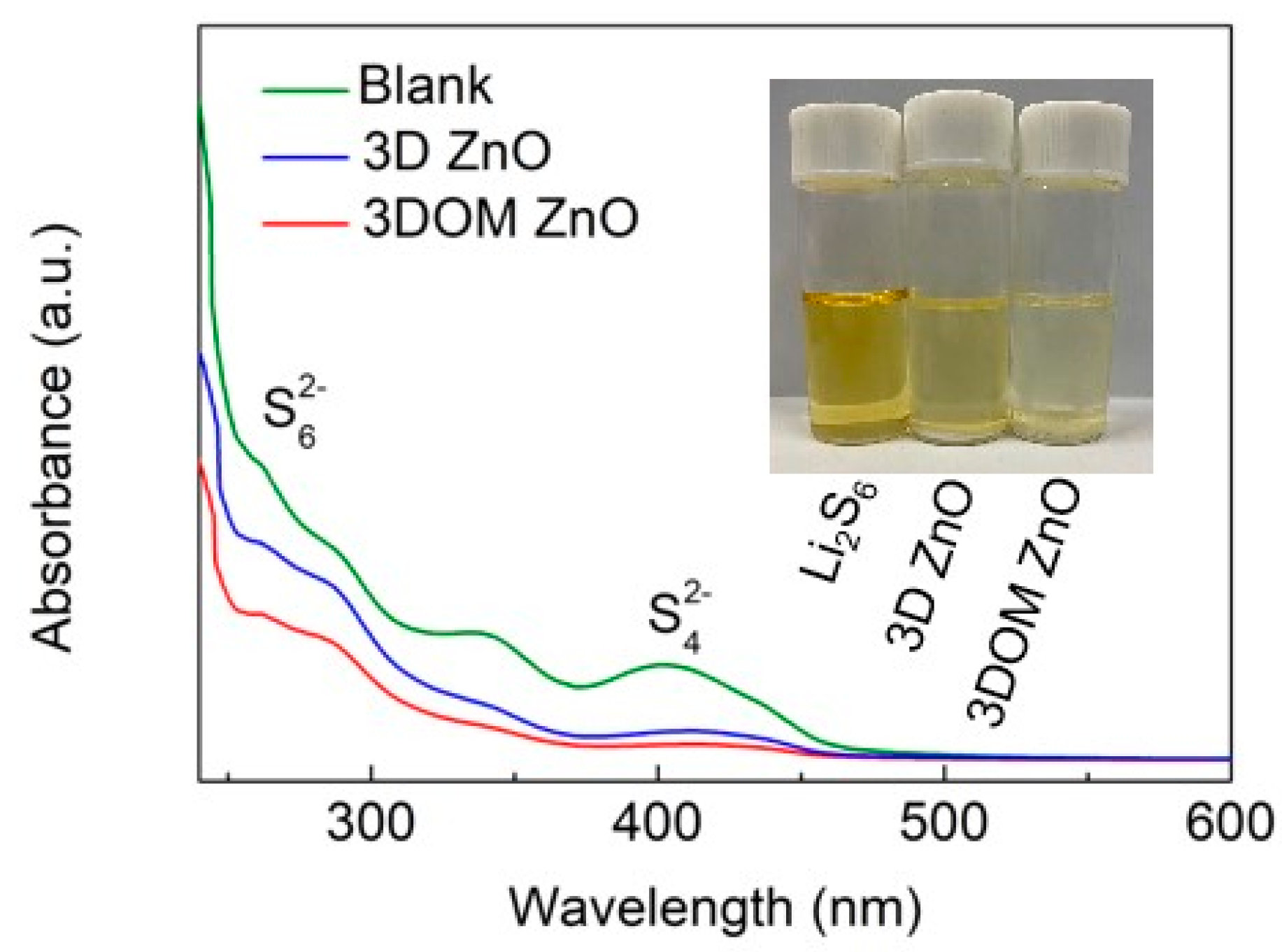
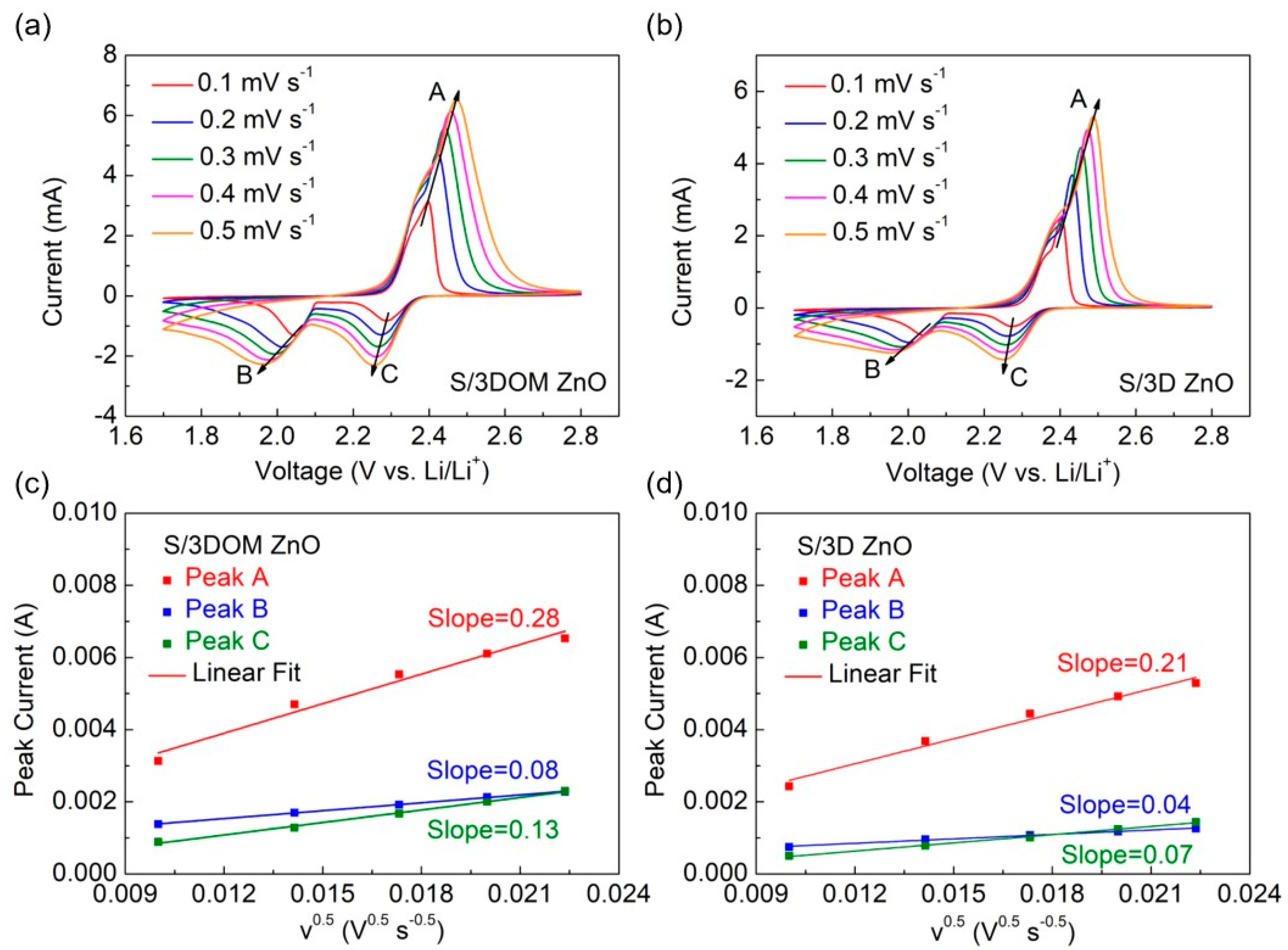
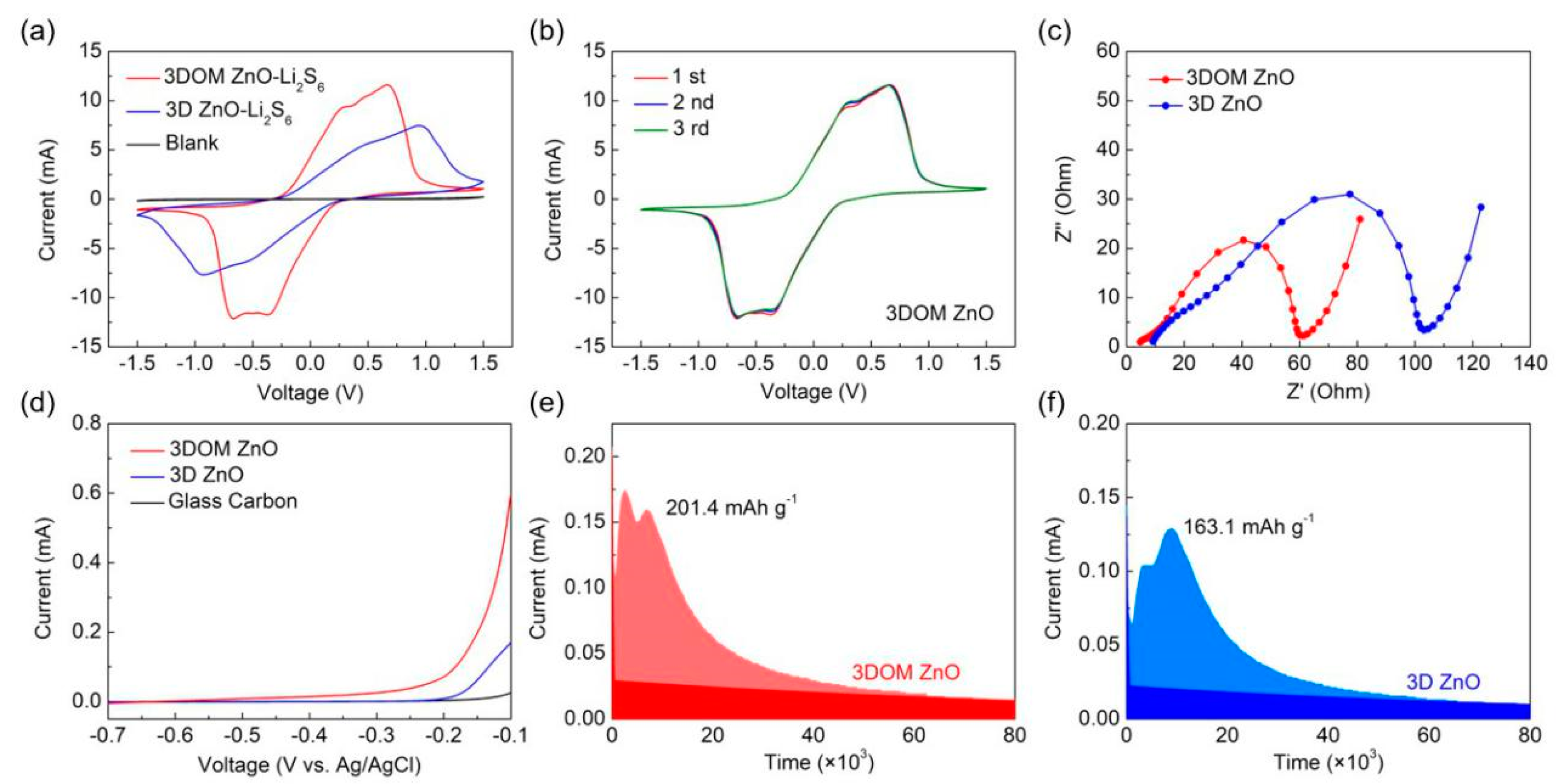
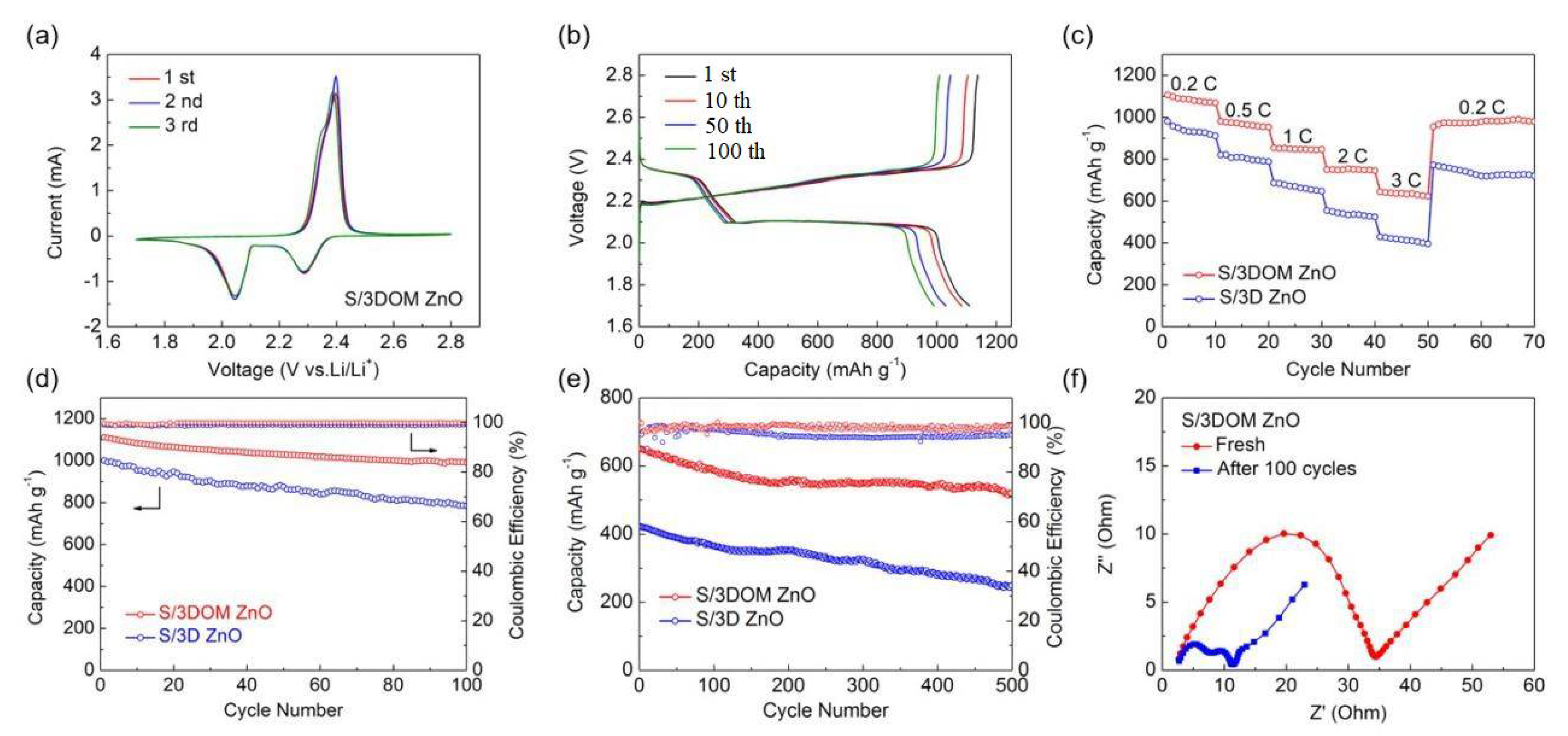
Publisher’s Note: MDPI stays neutral with regard to jurisdictional claims in published maps and institutional affiliations. |
© 2020 by the authors. Licensee MDPI, Basel, Switzerland. This article is an open access article distributed under the terms and conditions of the Creative Commons Attribution (CC BY) license (http://creativecommons.org/licenses/by/4.0/).
Share and Cite
Han, H.; Wang, T.; Zhang, Y.; Nurpeissova, A.; Bakenov, Z. Three-Dimensionally Ordered Macroporous ZnO Framework as Dual-Functional Sulfur Host for High-Efficiency Lithium–Sulfur Batteries. Nanomaterials 2020, 10, 2267. https://doi.org/10.3390/nano10112267
Han H, Wang T, Zhang Y, Nurpeissova A, Bakenov Z. Three-Dimensionally Ordered Macroporous ZnO Framework as Dual-Functional Sulfur Host for High-Efficiency Lithium–Sulfur Batteries. Nanomaterials. 2020; 10(11):2267. https://doi.org/10.3390/nano10112267
Chicago/Turabian StyleHan, Haisheng, Tong Wang, Yongguang Zhang, Arailym Nurpeissova, and Zhumabay Bakenov. 2020. "Three-Dimensionally Ordered Macroporous ZnO Framework as Dual-Functional Sulfur Host for High-Efficiency Lithium–Sulfur Batteries" Nanomaterials 10, no. 11: 2267. https://doi.org/10.3390/nano10112267
APA StyleHan, H., Wang, T., Zhang, Y., Nurpeissova, A., & Bakenov, Z. (2020). Three-Dimensionally Ordered Macroporous ZnO Framework as Dual-Functional Sulfur Host for High-Efficiency Lithium–Sulfur Batteries. Nanomaterials, 10(11), 2267. https://doi.org/10.3390/nano10112267




